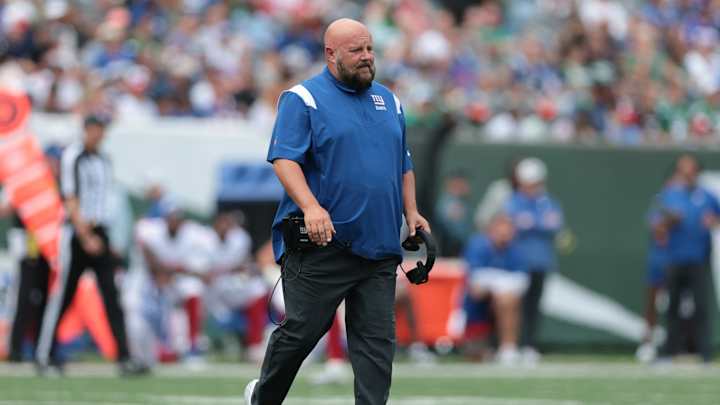How Giants Incorporate Analytics into Game Management Decisions

In the good old days, coaching an NFL was a little bit "feel" for a situation and a lot of luck.
But with the advent of analytics--a compilation of detailed data and statistics used to assemble various models to determine the outcome of any given scenario--deciding what to do in certain situations has become somewhat easier for an NFL head coach who already has an overflowing plate during a game.
Such is what Giants head coach Brian Daboll is discovering. Daboll has spent time on other coaching staffs that have leaned heavily on analytics. He has continued that practice with the Giants.
Every week, he reviews data models created by analysts and researchers he calls "the NASA room." Per the Giants' website, that team includes Football Data and Innovation Research Analyst Ben Burress, Football Data and Innovation Analyst Clark Ewen, Football Data and Innovation Coordinator Courtney Kennedy, and Football Data and Systems Coordinator Maxwell Kirin.
That team's work is presented by offensive assistant/game manager Cade Knox and director of football data and innovation Ty Siam, who review countless scenarios that may or may not arise in that week's game. Daboll is given probability outcomes on various scenarios and incorporates that data into certain game-day decisions.
"The meetings that I have with those two individuals (Knox and Siam), I would say, are very detailed, very well thought out," Daboll said. "I’m always asking the questions that I think I need to ask because there are certain things, I think, you marry it together."
The impact of the analytics team was on full display in the Giants' Sunday night win over the Washington Commanders when Daboll approved a decision to go for it on a 4th-and-9 from Washington's 35-yard line in the second quarter. That decision paid dividends for the Giants, who converted on an 11-yard pass from quarterback Daniel Jones to receiver Richie James. The Giants would later score their first offensive touchdown on a 3-yard rush by running back Saquon Barkley to take a 14-3 lead with 1:46 left in the first half.
"We knew that we would go for that in that particular situation on Wednesday after the morning meeting I had with (Knox and Siam)," Daboll said Monday. "Everyone contributed to the win. Those two guys were certainly a big part of it--two Ivy Leaguers, so try to listen to the Ivy Leaguers.”
While analytics play a heavy role in the Giants' decision-making, Daboll also uses other factors involving the eye test to make certain decisions.
"It’s not just, ‘This is exactly the number. This is what you should do," he said. "There’s a feel for a game. There is a ‘how’s it going?’. There’s a look in your players’ eyes...weather...matchups. As I said, we can go through it all day long, but if one of your linemen is struggling versus somebody, you got to make a decision."
"You kind of combine everything, and I don’t think you just take one thing and say this is what you do," he said. "I think you have to have a feel for the game, you gotta have a feel for your opponent, you gotta have a feel for the matchup, you gotta have a feel for the weather if something different. We are always in constant communication and just try to do what’s best for us.”
While Daboll admits to relying on analytics, he also isn't opposed to disagreeing with a suggestion if, in his estimation, a scenario has a chance of working despite what the data models say.
"I also think that you have to make sure that as a coach, you’re getting the ‘feel,’" he said. "You’re kind of monitoring your team, and again, the matchups, the flow of the game, the score, the situation. I think there are so many things that go into it. So, it’s not just ‘two times two equals four.’ There’s that, but then there are some other things that you have to consider.
"Those are the discussions that we have during the week. So, they might run through a couple of sheets, and I might go back and say, ‘Well, hold on a second. If we’re down by this, I’m going for one. I know what the numbers say, but I think I want to give the guys a chance to win and get a two-point conversion.'"
Even if he disagrees with the analytics, Daboll still appreciates the team that spends countless hours creating every possible scenario.
"It’s good give-and-take," he said. "I have a high opinion of those two individuals (Knox and Siam). They’ve helped a great deal, and I’m glad we have them."
Join the Giants Country Community
- Sign up for our FREE digest newsletter
- Follow and like us on Facebook
- Submit your questions for our mailbag
- Check out the new Giants Country YouTube Channel.
- Listen and subscribe to the daily LockedOn Giants podcast.
- Subscribe and like the LockedOn Giants YouTube Channel
- Sign up for our FREE message board forums
- Get your Giants tickets today from SI Tickets!
